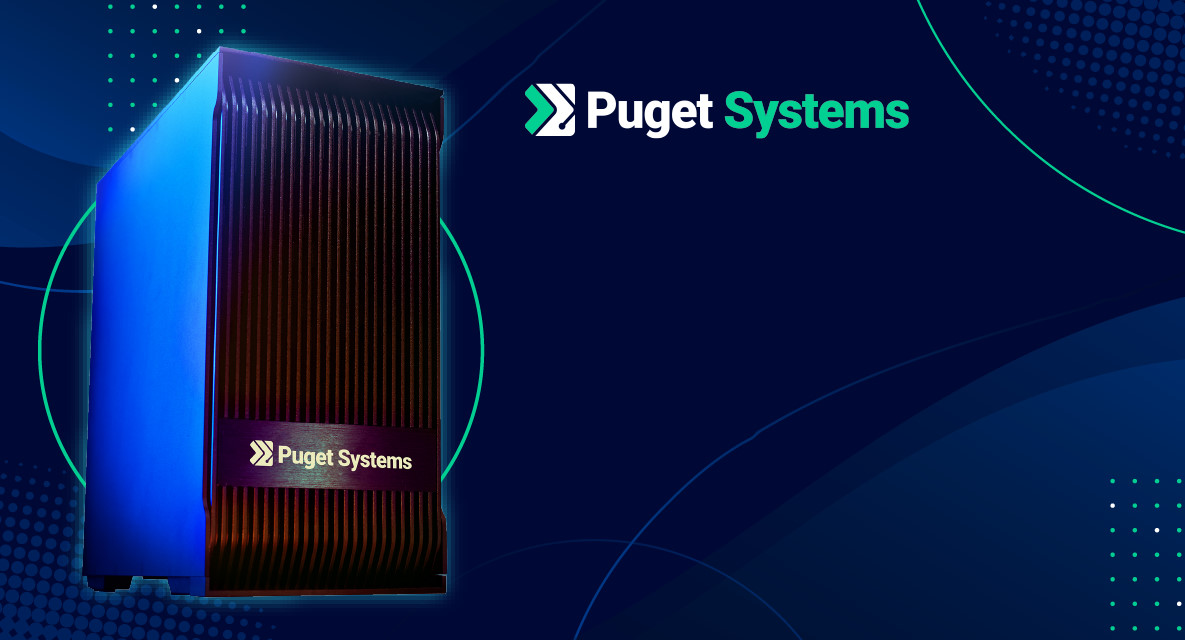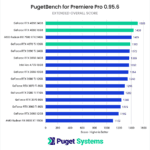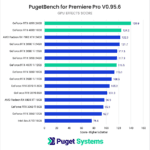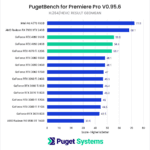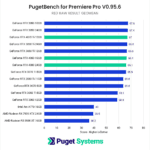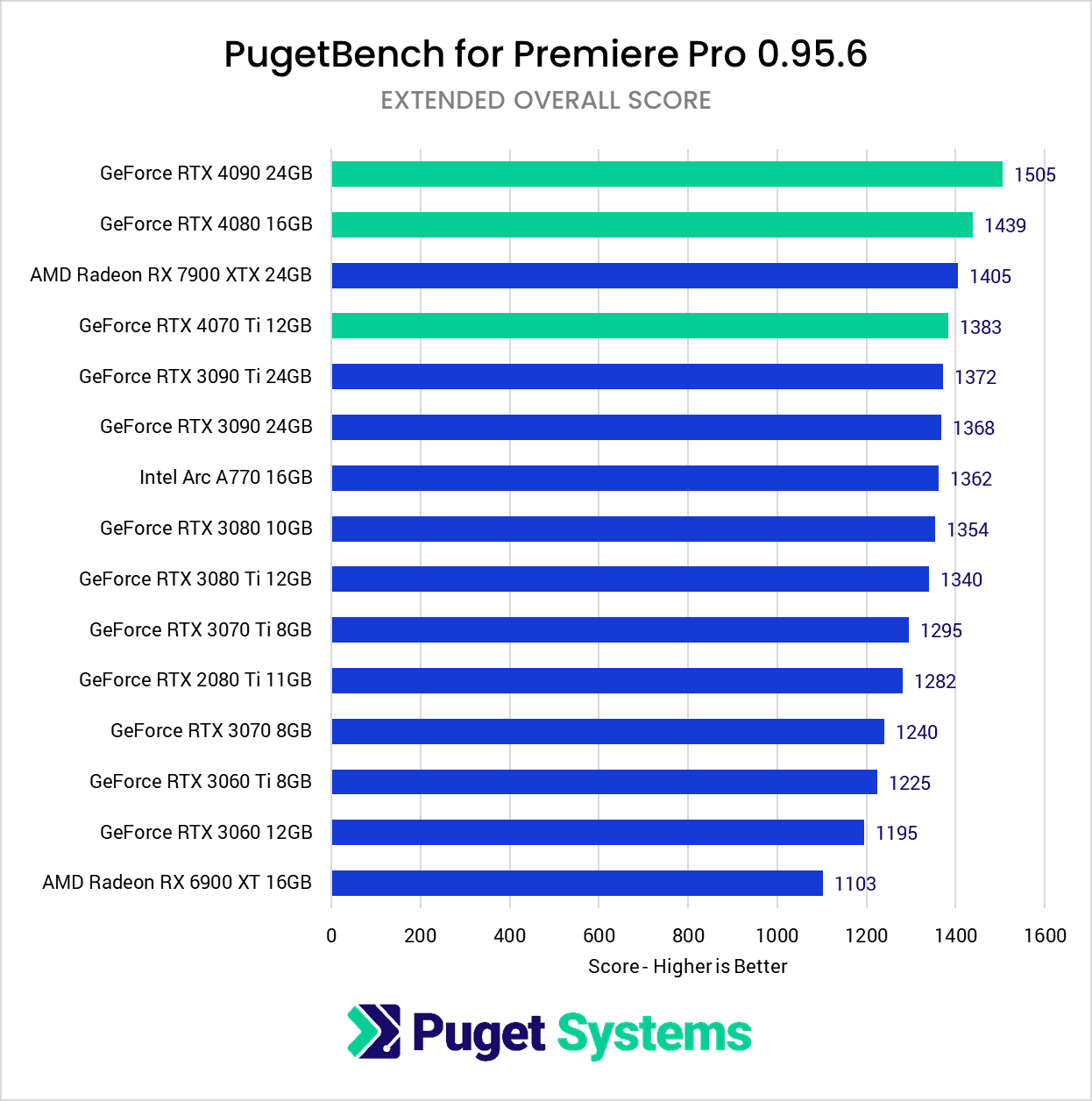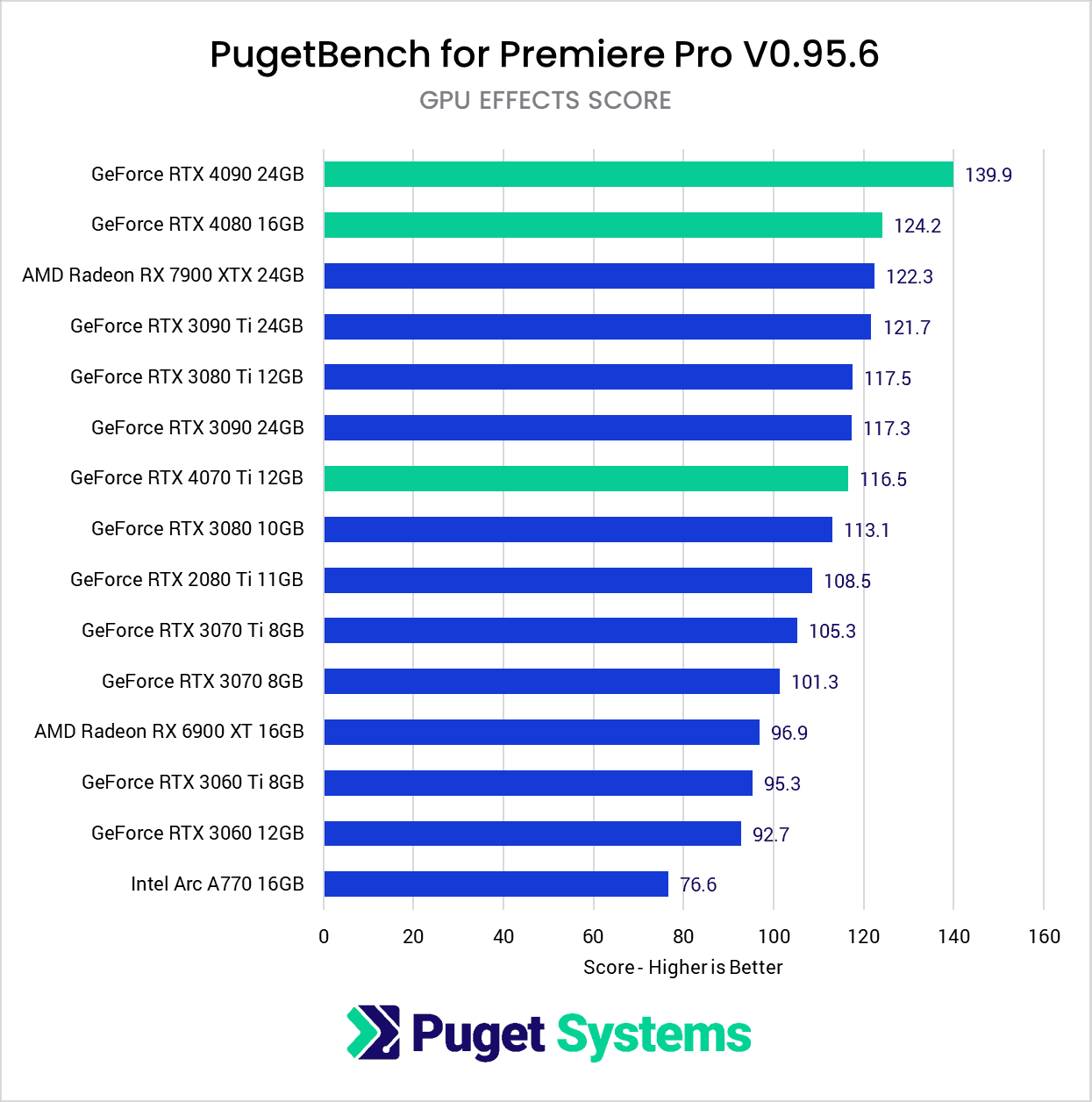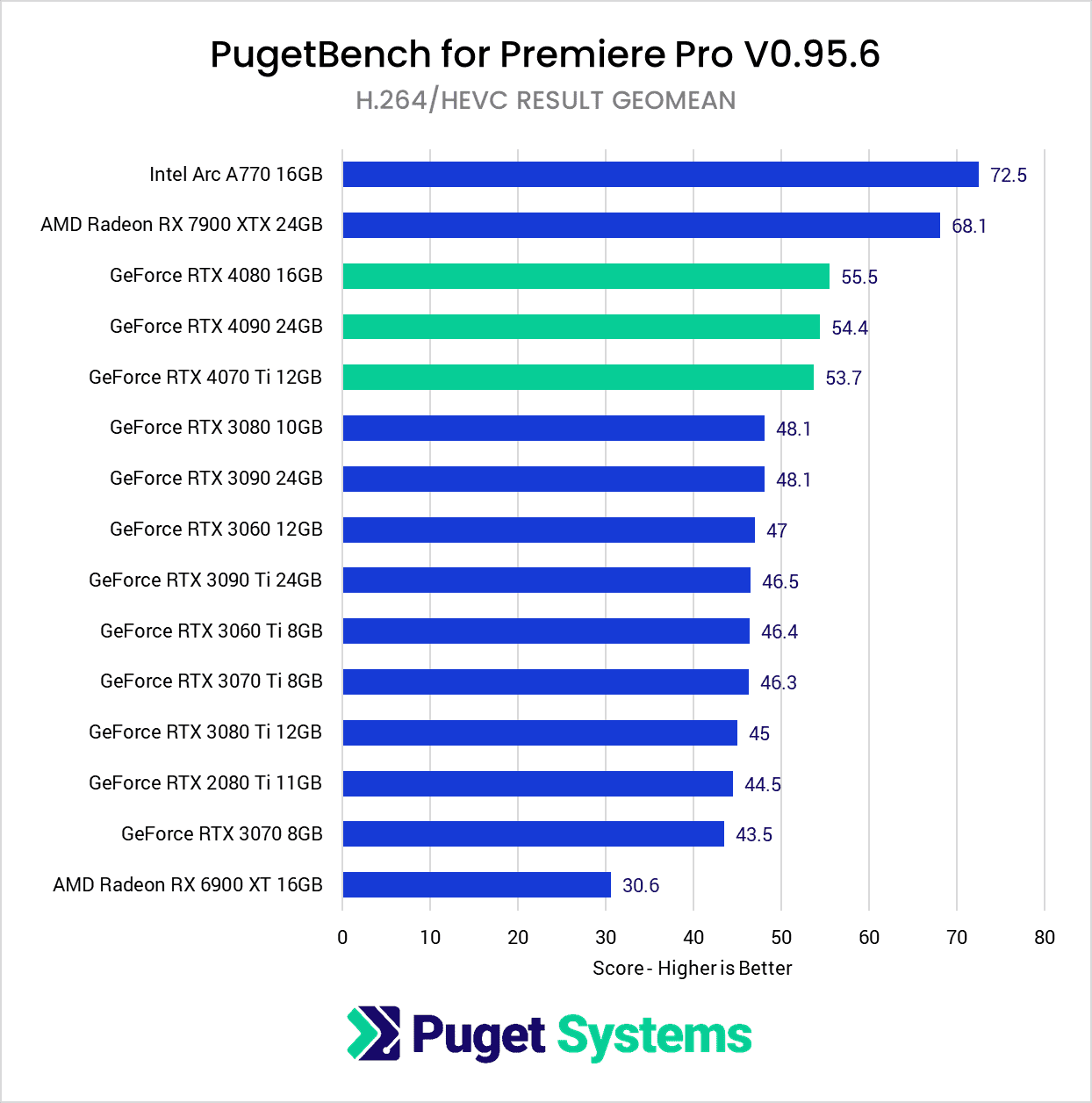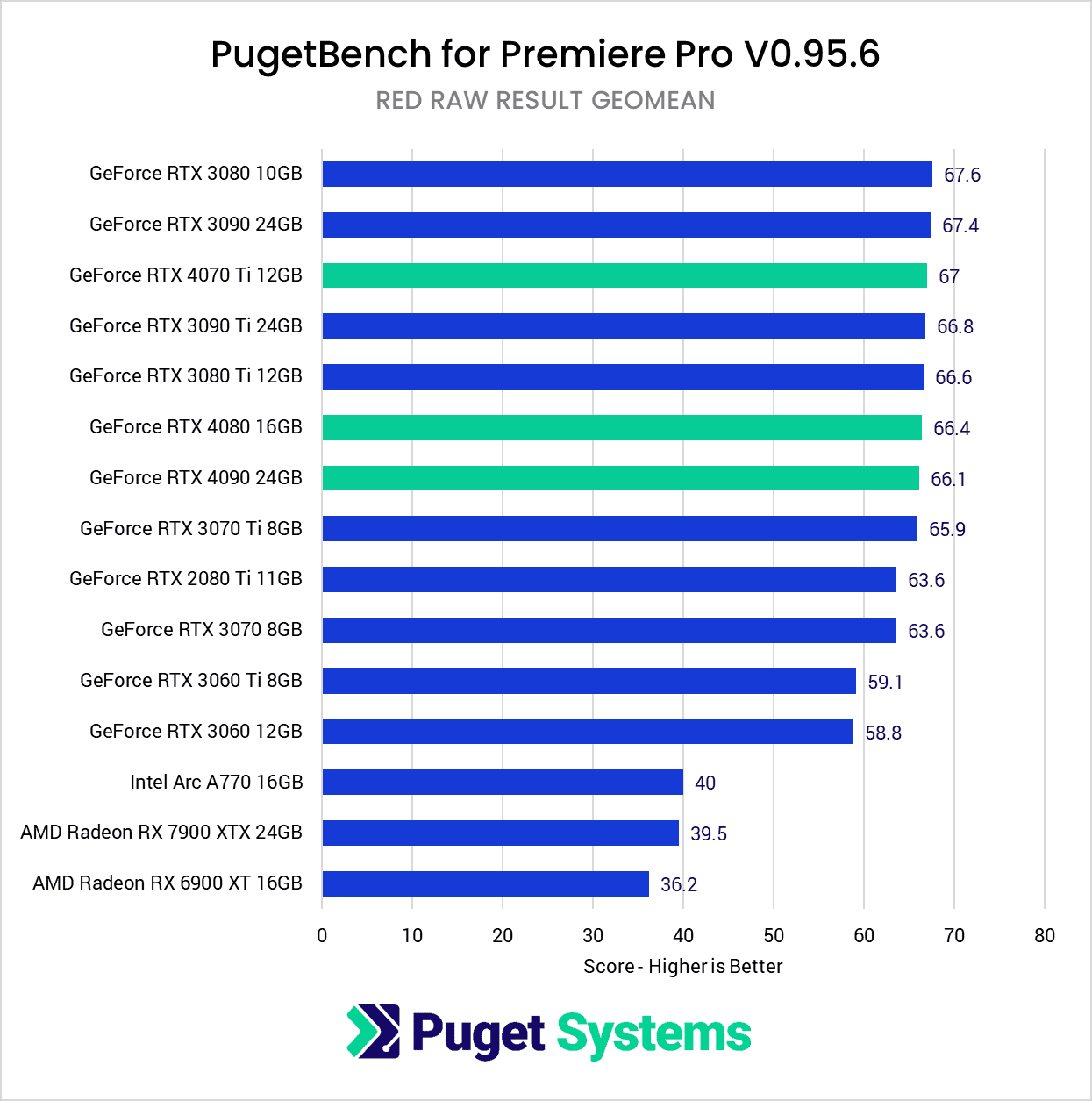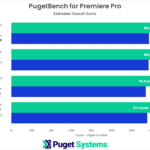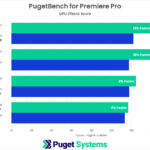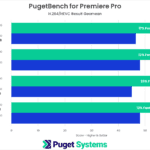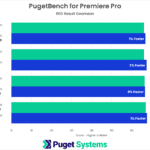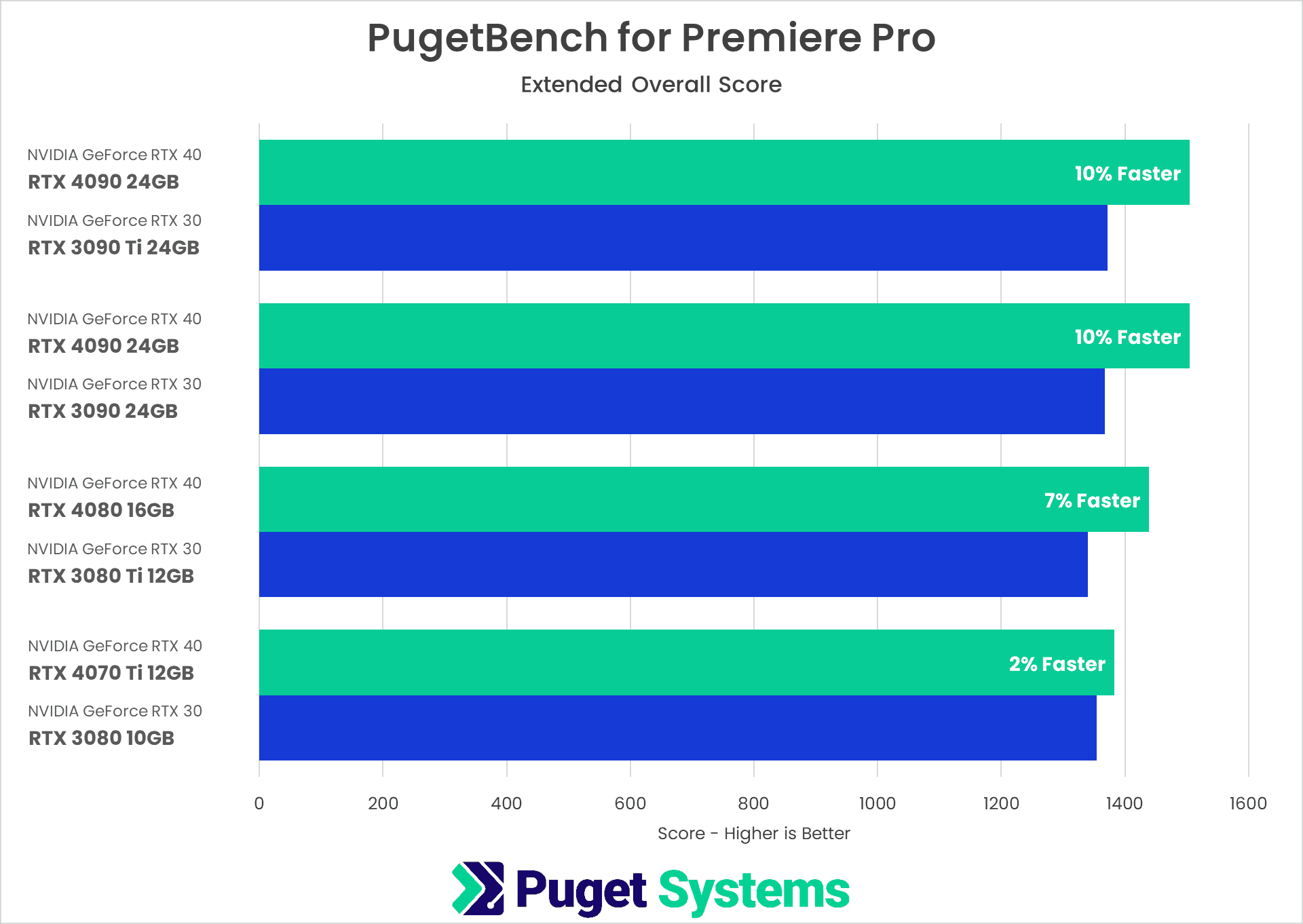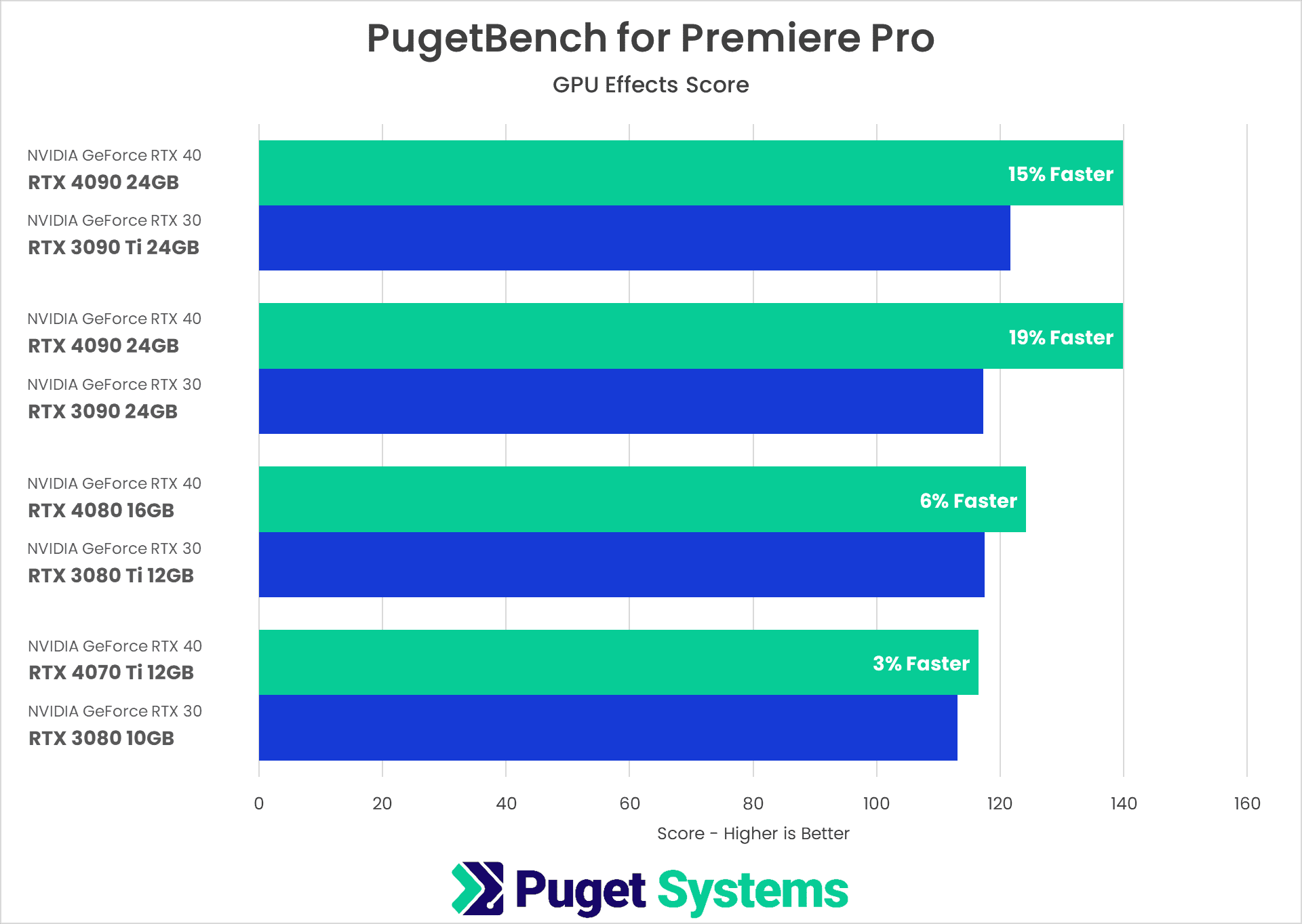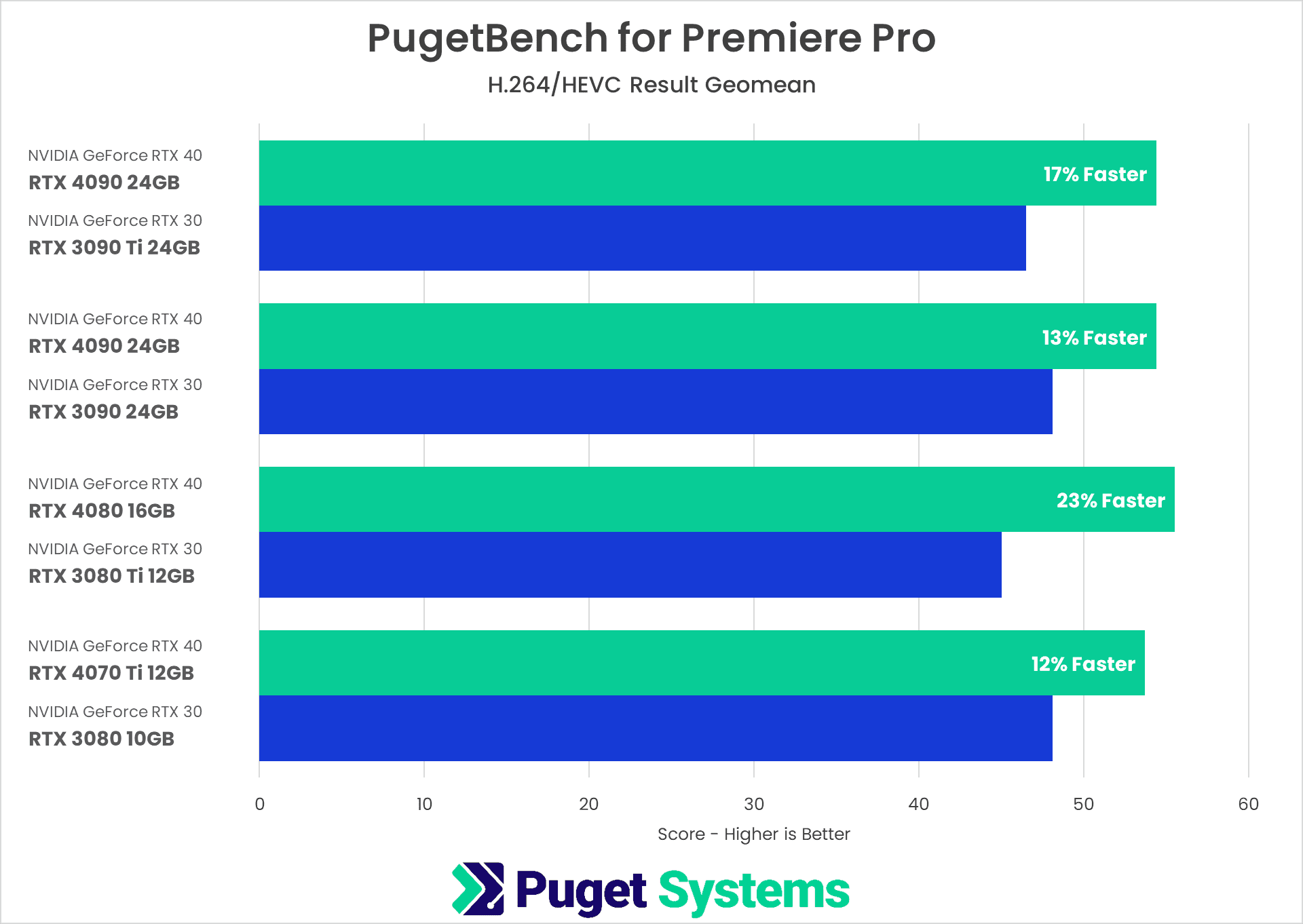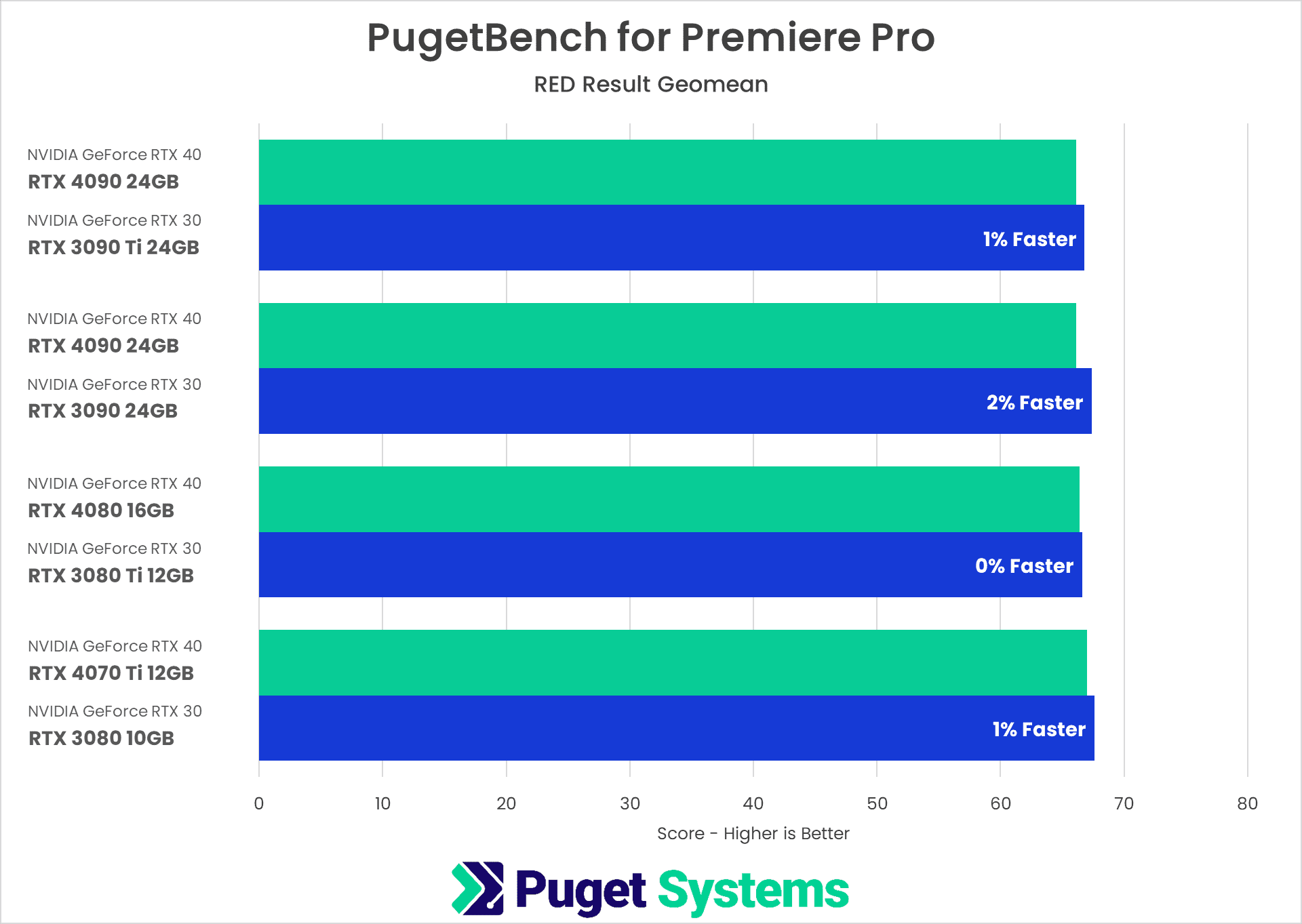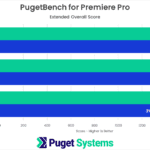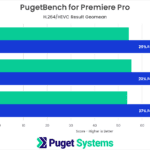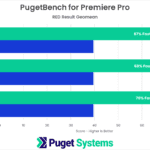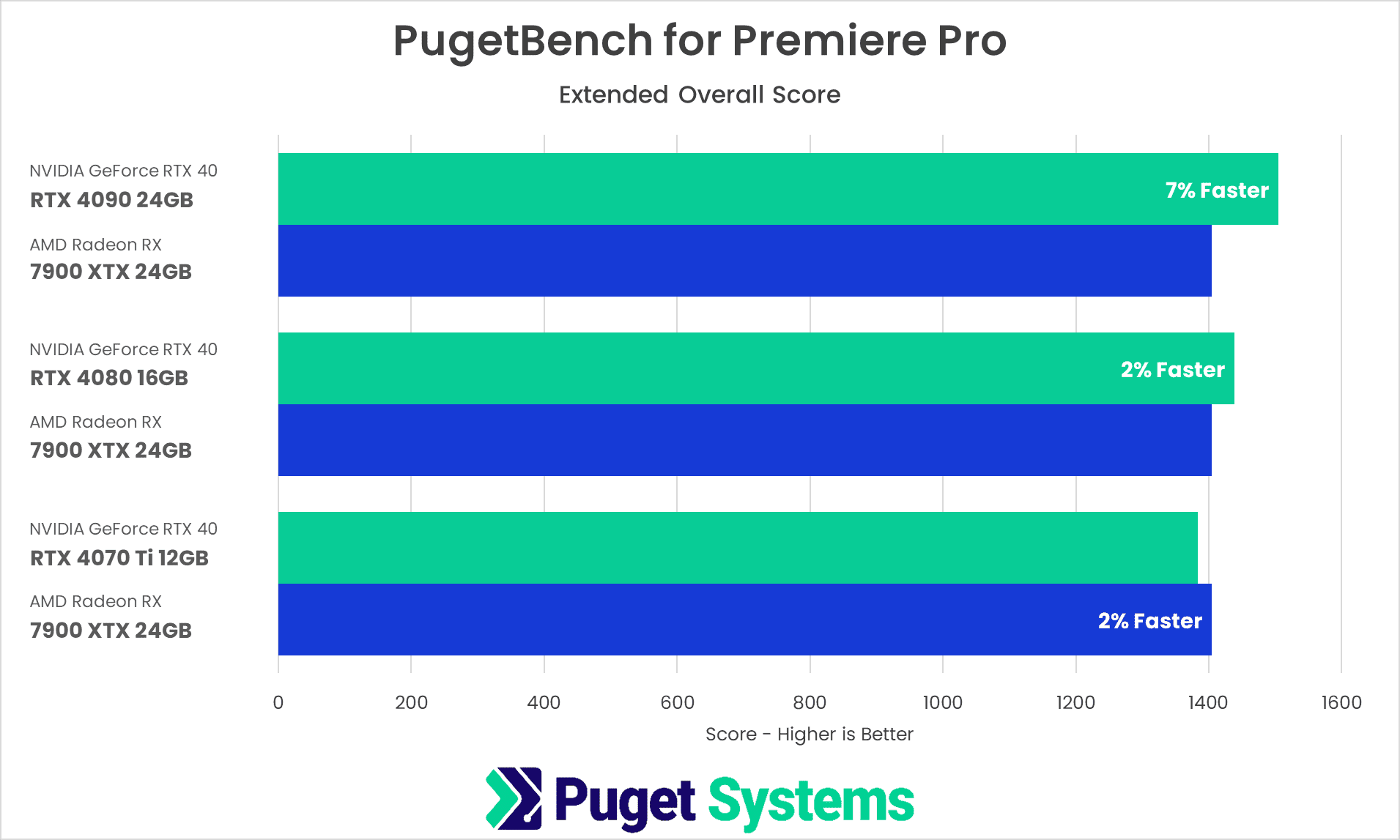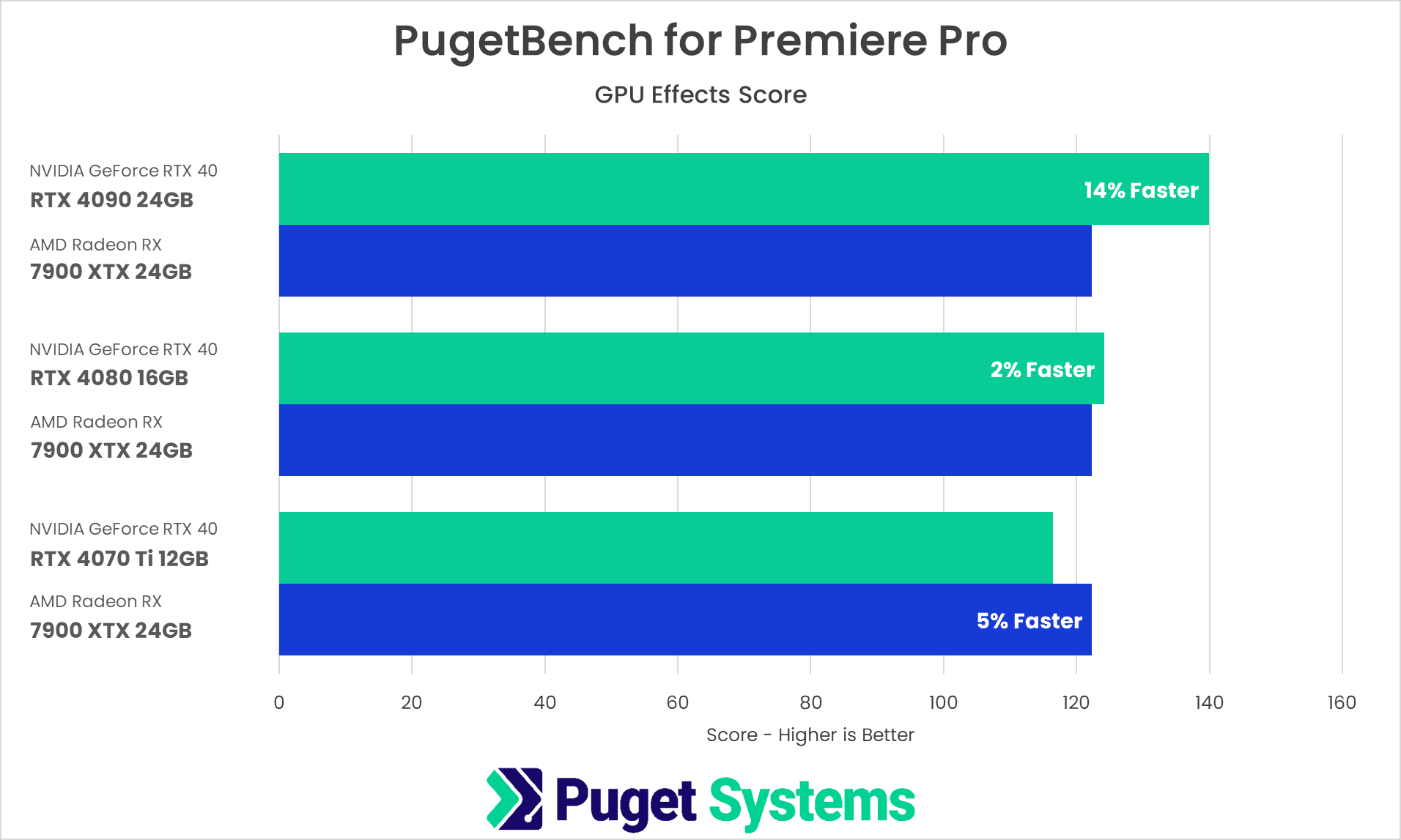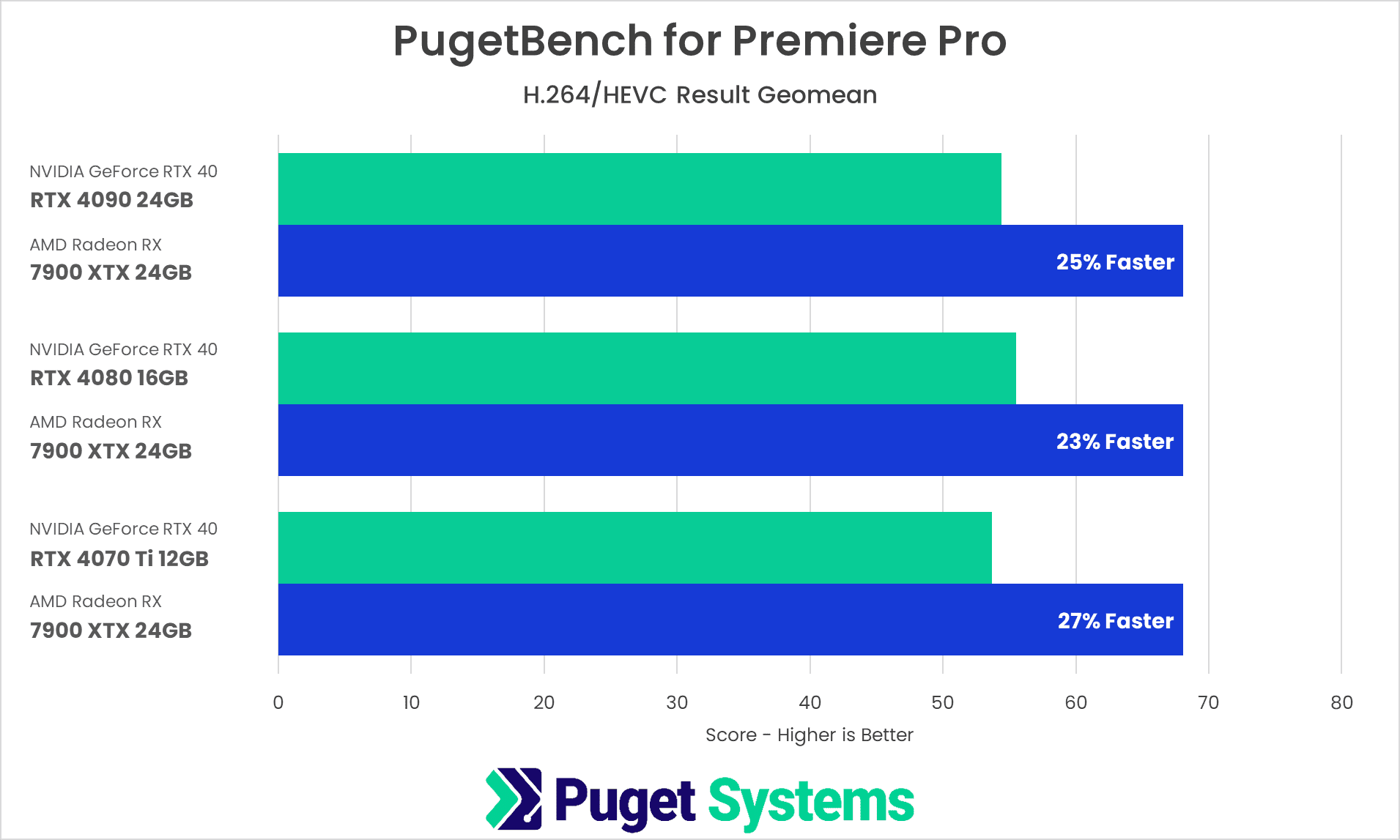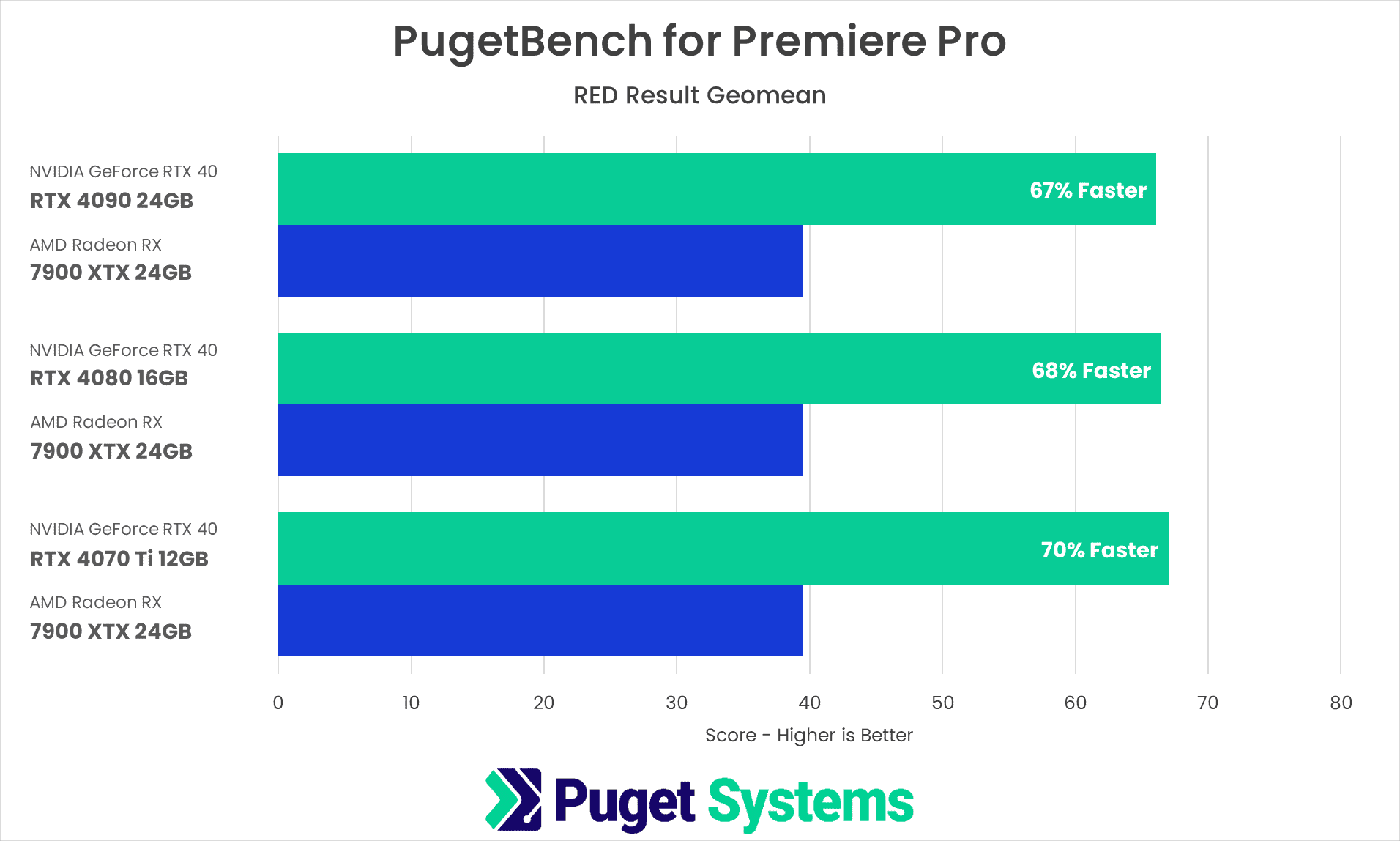Table of Contents
Introduction
With the GeForce RTX 4070 Ti 12GB, NVIDIA has completed the launch of their initial trio of GeForce RTX 40 Series GPUs that have been ongoing since October 2022. While lower-end GPUs are likely to come in the future, this is a good time for us to do in-depth testing to see how these 40 series cards perform in various content creation workflows.
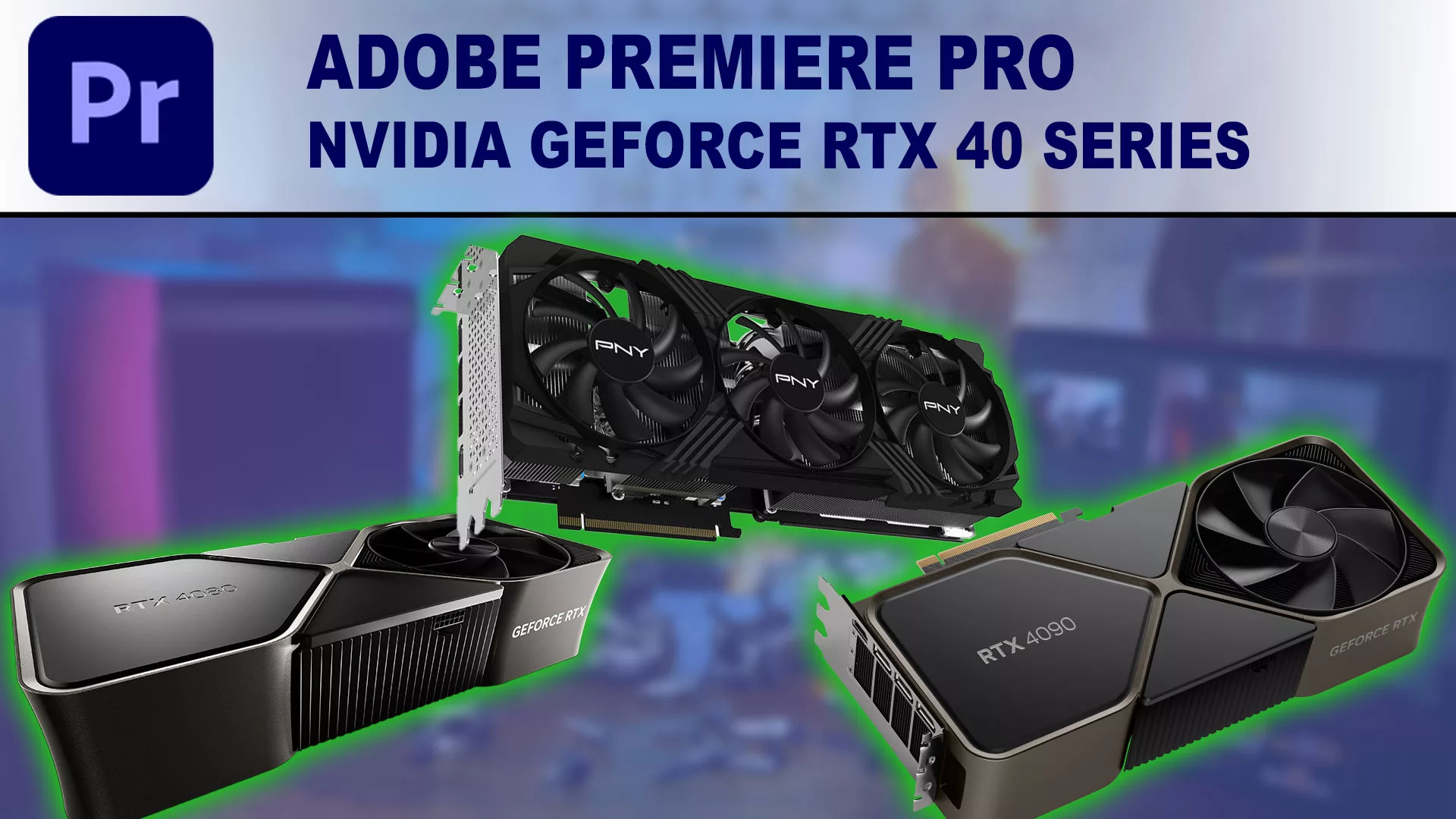
In this article, we will be using our PugetBench for Premiere Pro benchmark paired with Premiere Pro 23.1.0 to examine the performance of the GeForce RTX 40 Series for video editing. As a comparison, we will be including the full lineup from the previous generation GeForce RTX 30 series, the GeForce RTX 2080 Ti for additional context, as well as a sampling of cards from their primary competition – the AMD Radeon RX Series.
If you want to read more about the new GeForce RTX 40 Series cards (including the 4070 Ti, 4080, and 4090), and what sets them apart from the previous generation, we recommend checking out our main NVIDIA GeForce 40 Series vs AMD Radeon 7000 for Content Creation article. That post includes more detailed information on the GPU specifications, testing results for various other applications, and the complete test setup details for the hardware and software used in our testing.
Raw Benchmark Results
While we will be going through our testing in detail in the next section, we always like to provide the raw results for those that want to dig into the details. If there is a specific task you tend to perform in your workflow, examining the raw results will be much more applicable than our more general analysis.

Overall Premiere Pro Performance Analysis
When it comes to GPU performance in Adobe Premiere Pro, there are four main areas we typically focus on:
- Overall Score across all tasks
- GPU-accelerated effects performance
- H.264/HEVC decoding/encoding performance
- RAW debayering performance
While the Overall Score is likely to be the most relevant single result for most users as it is a combination of various workflows in Premiere Pro, it does include several tasks that don’t utilize the GPU much. It lines up with how most people use Premiere Pro day-to-day, but if you want to take a closer look at how different cards impact performance in more GPU-focused workloads, that is where the other scores come into play. We will note that the H.264/HEVC and RAW scores in charts #3 and #4 above are not currently a part of our public benchmark. This is something we plan on focusing more heavily on in upcoming versions of our Premiere Pro benchmark, but for now, we are calculating those scores after the fact by using a geometric mean of the relevant tests.
A lot is going on in the charts above, so what we are going to do is to break down the results based on the two main questions the majority of readers are likely to be interested in: How does the RTX 40 Series compare to the previous generation RTX 30 Series, and how they compare to their primary competition from AMD.
NVIDIA GeForce RTX 40 Series vs RTX 30 Series
We usually like to make comparisons based on the pricing of each GPU, but it is worth noting that GPU pricing is still extremely volatile. We will use the base MSRP as a baseline in this post, but be aware that exact apples-to-apples comparisons may change according to current market pricing. But, in terms of MSRP, the closest comparisons between the new RTX 40 Series cards and the previous generation are:
- RTX 4090 24GB vs RTX 3090 24GB ($1,599 vs $1,499)
- RTX 4080 16GB vs RTX 3080 Ti 12GB ($1,199 vs $1,199)
- RTX 4070 Ti vs RTX 3080 10GB ($799 vs $699)
In addition, we also decided to throw in the RTX 4090 24GB versus the RTX 3090 Ti 24GB ($1,599 vs $1,999) as a “best of both generations” comparison.
Starting with the Overall Score, the RTX 4090 showed the biggest gains over the previous generation, with a 10% performance bump over the RTX 3090 and 3090 Ti. For a mixed CPU/GPU workload like this, that is a respectable performance increase. The RTX 4080 also provides decent gains with about a 7% increase over the RTX 3080 Ti, but the RTX 4070 Ti is a bit of an under-performer, showing just a 2% increase over the RTX 3080. If we were to compare it to the RTX 3070 Ti, it would be closer to a 7% gen-over-gen gain, but considering that the 4070 Ti is more expensive than even the RTX 3080, we don’t feel that a “4070 Ti vs 3070 Ti” comparison is valid.
As we mentioned earlier, however, the Overall Score includes many workloads that do not heavily utilize the GPU. Because of this, we also want to drill down into some of the specific workloads in Premiere Pro that make better use of a more powerful GPU. First up, in chart #2 we are looking at the performance for GPU-accelerated effects like blurs, lumetri color, and noise reduction. Interestingly, the RTX 4070 Ti and RTX 4080 show almost the same gen-over-gen performance gains as the Overall Score with a 3% and 6% increase, respectively. The RTX 4090, on the other hand, shows a massive 19% performance gain over the RTX 3090, and a 15% gain over the more expensive RTX 3090 Ti.
In addition to GPU-accelerated effects, your GPU choice can also impact performance when working with specific codecs. Currently, the two most common codecs where the GPU comes into play are decoding/encoding for LongGOP codecs (H.264 and HEVC in our benchmark), and debayering of RAW media (RED RAW in our case).
H.264 and HEVC codecs are among the most commonly used codecs for video editing (even if they are also among the worst for editing performance), and Premiere Pro shows some very nice performance gains with the RTX 40 Series cards. The exact amount varies by model, but in chart #3, you can see that we measured anywhere from a 12% to 23% increase in performance over the previous generation. This will only come into play if you are working with specific types of H.264 and HEVC media that Premiere Pro has Hardware Decoding support for, but in those cases, the RTX 40 Series cards give an excellent performance bump.
On the other hand, RAW debayering (chart #4) isn’t as great of a result for the RTX 40 Series, with performance that is effectively identical to the previous generation. If you look at the full chart for this test in the previous section, you will notice that we appear to hit a performance wall once we got up to the GeForce RTX 3070 Ti. While we are using one of the best CPUs for this type of media, we are likely simply being bottlenecked by the CPU, resulting in more powerful GPUs not being able to give us any additional increase in performance.
NVIDIA GeForce RTX 40 Series vs AMD Radeon RX
Unlike NVIDIA, AMD has a fairly slim GPU product line. They don’t have anything approaching the MSRP of the GeForce RTX 4090, and only have two models currently available for their Radeon 7000 Series: the Radeon RX 7900 XT and the Radeon RX 7900 XTX. For the purposes of this article, we are only going to include the Radeon RX 7900 XTX in this section. Just keep in mind that the 7900 XTX is $200 more expensive than the 4070 Ti, $200 less expensive than the RTX 4080, and far less expensive than the RTX 4090. Because of this, we are never going to be looking for an exact match in terms of price/performance, but rather how NVIDIA and AMD compare on a relative level.
Starting with the Overall Score, the relative performance between AMD and NVIDIA is almost exactly in line with the MSRP of each card. The Radeon 7900 XTX is a bit faster than the RTX 4070 Ti, but slightly behind the RTX 4080. However, this is just looking at the overall performance of each card, and there are some great nuggets when we drill down into different workloads.
First, in chart #2 we are looking at the performance of GPU-accelerated effects in Premiere Pro. Here, the results are remarkably similar to the Overall Score. AMD and NVIDIA both do well in terms of performance, so if GPU effects are a concern for your workflow, it will come down to other factors. The 24GB of VRAM on the 7900 XTX is certainly a benefit for AMD, but NVIDIA also has things going for them such as their (historically in our experience) more stable drivers. The benefit of each of these is subject to what you want to prioritize for your system, however, so we would say that AMD and NVIDIA are largely a wash for this test.
Things get more interesting when we examine the performance of different types of codecs. In our H.264 and HEVC tests (chart #3), the AMD Radeon 7900 XTX showed a solid 23-27% performance lead over the NVIDIA GeForce RTX 40 Series cards. You could make up for NVIDIA’s deficit in this area if you use an Intel Core CPU that supports Quick Sync (as that would be used for H.264/HEVC decoding in place of the GPU), but if that isn’t an option, AMD is a stronger choice for any LongGOP codecs that Premiere Pro has GPU decoding support for.
Last up is the performance of RED RAW media (chart #4). Here, NVIDIA has a very firm lead over AMD with the NVIDIA GeForce RTX 40 Series cards showing roughly a 70% performance advantage over AMD. RED (and RAW codecs in general) are not as widely used as LongGOP codecs like HEVC or IntraFrame codecs like ProRes, but if you work with RAW media in Premiere Pro, NVIDIA is really the only choice in terms of straight performance.
How Well Do the NVIDIA GeForce RTX 40 Series Perform in Premiere Pro?
Overall, the NVIDIA GeForce RTX 40 Series GPUs do very well in Premiere Pro, but in most cases are an incremental improvement over the previous generation. High-end users are the ones who would benefit the most from an upgrade, as the new RTX 4090 can give you up to a 20% performance increase over the RTX 3090 in some workloads. But for the RTX 4080 and 4070 Ti, you are usually only looking at a 5-10% increase in performance.
The area where the 40-Series showed the most performance gain was when working with H.264 and HEVC media, but that is also the main area where AMD has the biggest lead over NVIDIA with their Radeon 7900 XTX. And in fact, we would argue that if performance for these types of media is critical for your workflow, more important than what GPU you use is to utilize an Intel CPU that supports Quick Sync. Not only is Quick Sync typically faster than using either NVIDIA or AMD GPUs, but it also supports a broader range of HEVC variations.
In terms of NVIDIA vs AMD, we would say that NVIDIA holds the lead over AMD at the moment, although choosing between the two brands isn’t always going to be completely straightforward. The main advantages of the AMD Radeon RX 7900 XTX is its stronger performance with H.264/HEVC media (if you can’t take advantage of an Intel CPU with Quick Sync), and the fact that it has 24GB of VRAM. If neither of those is a requirement for your workflow, however, we would give the edge to NVIDIA based not only on performance but also on less tangible things like application support and stability.
What this all means is that for most Premiere Pro users, the RTX 40 Series GPUs are going to be our primary recommendation going forward. They are not massively faster than the previous generation, but they are a better value simply from a price-to-performance standpoint than older GeForce cards. If your budget isn’t quite up to an RTX 4070 Ti, the RTX 3070 and below are still solid cards, but if you are looking for something in the $800+ range, the RTX 40 Series is going to be our go-to choice.
If you are looking for a workstation for Premiere Pro with an NVIDIA GeForce RTX 40 Series GPU, we recommend checking out our Premiere Pro solutions page or contacting one of our technology consultants for help configuring a workstation that meets the specific needs of your unique workflow.

